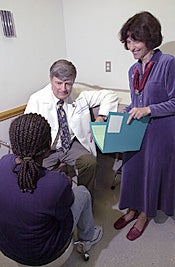Pediatricians looking into best way to treat children with ADHD
GREENVILLE, N.C. (Apr. 2, 2002) — Three local pediatricians are taking part in a national collaborative effort to develop the best standards of treatment for children with attention-deficit/hyperactivity disorder.
Drs. Chuck Willson and Bob Hoyer of the Department of Pediatrics at the Brody School of Medicine at East Carolina University and Dr. Tate Holbrook of Children’s Health Services are participating in a program to develop “best standards of care” for children with ADHD by sharing information with other pediatricians across the country.

Dr. Charles Willson, center, and Anne Hoyer, ADHD case manager, speak with a patient at the ECU Pediatric Outpatient Center. ECU is participating in a national program to develop best-practice standards for ADHD. Photo by Cliff Hollis.
The program is being facilitated by the National Initiative for Child Healthcare Quality and is the first collaborative learning effort focused on improving care for children with ADHD while developing tools and materials that support new clinical guidelines from the American Academy of Pediatrics.
“There is a lot of controversy in the treatment of children with ADHD,” said Willson, who is also assistant dean for physician affairs at the medical school. “They are bringing the experts in the care of ADHD onto a special Web site to exchange information.”
The physicians exchange ideas and approaches that have worked in their practices via a special Internet bulletin board. The physicians also have face-to-face conferences to address specific areas of ADHD treatment, such as the Vanderbilt screening assessment for parents and teachers and how conditions like depression affect the diagnosis and treatment of ADHD.
“We have to diagnose not just ADHD but the other conditions that come with it,” Willson said.
ADHD is the most common behavioral health condition that affects children. As many as 5 percent of school-aged children are on stimulant medication and the increasing use of psychotropic drugs in childhood has raised widespread concern among policy makers about cost and outcomes, according to information on the NICHQ Web site.
Ritalin, or methylphenidate, helps people with ADHD by increasing levels of dopamine, a neurotransmitter, in the brain. That leads to improved attention and focus in people who have dopamine signals that are weak, such as those with ADHD.
The yearlong research initiative, which began in September, is being funded by the North Carolina Division of Medical Assistance, the American Academy of Pediatrics and The Robert Wood Johnson Foundation. Five practices in North Carolina are participating, with 33 total across the country. The program’s goal is to have a redesigned system addressing diagnosis and caring for children with ADHD by 2005.
The questions the pediatricians are focusing on include the best way to diagnose ADHD in a primary care office, the best way to treat the patient with medication or behavioral management and the most effective follow-up on the children.
“We estimate that in grade-school level we have 500 children in Pitt County taking medication for ADHD,” Willson said. “That’s 5 to 10 percent of school-aged children. And there’s probably another several hundred in high school, but we’re not addressing (that age group) at this point.
“There is no national consensus on how to diagnose this condition. Our findings will be put into a national registry. We hope it will help make a national standardized consensus leading to better treatment with medication, behavioral modification or both,” Willson said.
“At University Health Systems of Eastern Carolina we have one school ADHD nurse, Rexanne Davis, and she links children with their primary care physicians,” he said. Her salary is funded by a community health benefit grant from the Pitt Memorial Hospital Foundation.
ADHD has been in the spotlight for years since physicians began having a name for the condition, which causes children to be over active at times, have short attention spans or act without thinking. “I think ADHD has always been there, but it was just not identified,” Willson said.